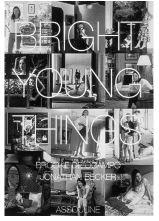FIRST THERE WAS the Social Register, that blue-blooded bible brimming over with preppies-turned-yuppies-turned-yetties-turned-bobos, accompanied by (but not necessarily separate from) the ever-shifting pantheon of Its. Now, just in time for the holidays, the Bright Young Things have arrived to enhance the coffee tables of the haves and have-nots alike. As in all the categories of privilege, you can either pledge allegiance to or curse ’em; you can wish them away or wish they’d invite you for cocktails and black-tie theme dinners.
Bright Young Things
by Brooke de Ocampo, photographs by Jonathan Becker (Assouline, $50)
You, sitting at home in remote, new-moneyed Seattle where Sasquatch and bandwidth are king, may recognize their pretty faces and insouciant pouts from fashion magazine gossip columns or Vanity Fair spreads. And if you can’t stand that sparkling, couture-clad coterie made up of Lauders and Von Furstenbergs, you’ll find nothing but fodder for your continuing scorn in Bright Young Things, an intrusive yet vicarious look at the good life enjoyed by the Big Apple’s newest generation of elites. Socialite and thirtysomething mother of three Brooke de Ocampo—a card-carrying BYT herself—grants us access, with sumptuous photographs by Jonathan Becker, to the domiciles of the young, rich, and powerful. (Some assembly required; dogs, chandeliers, and original Basquiats definitely included.)
A Bright Young Thing, according to this pictorial tome’s introductory essay by William Norwich, is someone whose well-honed style moves beyond mere tradition to fuse the latest incoming trend with a savvy, individualized sense of space. “Exceedingly influential, [BYTs] speak the language of Style with sounds, and symbols, that signify a global mix, the worlds of interior design and fashion constantly melding. . . . The BYTs aren’t swans, no. Instead, as the age commands, they are social sailors, negotiating modern gods and sirens in an odyssey of personal style on the treasured island of Manhattan.”
AMONG THE 27 HOUSEHOLDS represented in Bright Young Things, there are uptown pads that took more than a year, several architects, and a few Matisses to complete; downtown storefronts that serve as an artist’s live/work space; tiny Greenwich Village garden apartments; fabric-swathed bohemian lofts; pieds-୴erre for European jet-setters; and antiques, antiques, antiques.
A few famous names pop out right away. The techno artist Moby lives but a few blocks from where his image adorned a billboard for Calvin Klein on the Lower East Side. His spare, “Zen-Scandinavian” loft accommodates his recording studio, an old wooden fire-engine ladder, soundproof floors, and his all-important fax machine. As if to prove that the musician would have added some other, homier touches if his grueling tour schedule let up in the least, the final image Becker leaves us with of this abode is of an itinerary, hot off the fax.
Estee Lauder’s granddaughter, Aerin, who stands to inherit the top seat at her family’s cosmetics empire, appears in the front hall of her imposing Upper East Side apartment with her cocker spaniel. Pictured without her baby and husband, who surely must have weighed in on the powder blue bedroom walls, the Jean-Michel Frank table, and the dressings for the fabulous casement windows, Lauder stands poised and serene, frozen in an immaculate landscape. She’s like a statue that’s sometimes placed by a window in a brown silk shift or on the couch, pedicured, in a Tuleh gown. Her pooch, groomed and intent on his mistress, could be made of porcelain.
Other faces in the style parade include Lauder’s younger sister Jane, Alexandra Von Furstenberg, fashion designer Carolina Herrera’s daughter Patricia, artist Damian Loeb, Marshall Fields heiress Marina Rust O’Connor, Ralph Lauren’s son Andrew, MTV correspondent Serena Altschul, and Michael and Tara Rockefeller. From Michelle and George Andrews’ sarcophagus bathtub to the questionable inclusion of a handwritten apology by Nancy Jarecki’s hired help (“I’m sorry if I didn’t fold your clothes like you usually do. I hope you like my job. . . .”), there is a lot to take in about how these Crats (aristocrat, meritocrat, whatever) inhabit not just their private spaces but the world at large. And how, despite their big-deal careers and social obligations, they’re determined to create spaces of repose and inspiration.
Page after page in Bright Young Things illuminates something else about these people who pose from their living rooms and boudoirs and terraces: As carefully arranged as the most expensive paintings and throw pillows, their lifestyles are cast for posterity in a socioeconomic light that simultaneously repels and seduces the viewer. What de Ocampo has done, and done convincingly, is to assemble these style mavens at a particular juncture in their ascension and get them to share the ideas behind their private spaces with the public. Persian rugs, gourmet kitchens, and fresh flower arrangements aside, it’s something anyone on any level can relate to—the need for a place to put your stuff.








